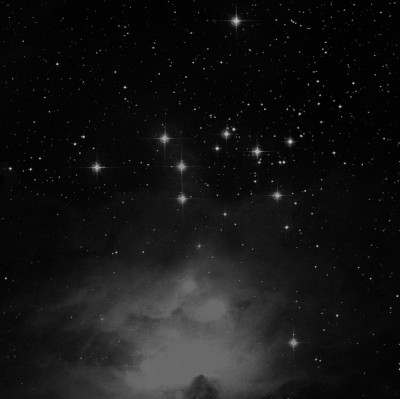Upper Sword
Upper Sword

John Herschel discovered NGC 1981 = h362 on 4 Jan 1827 (sweep 41) and described "a coarse and por but very splendid cluster of large stars; a beautiful object." His position corresponds with mag 6.5 HD 37040 = ?750 = mag 6/8 at 4" on the NE side of the cluster.
But by analyzing William Herschel's early "reviews" of bright stars (before his systematic sweeps), Wolfgang Steinicke recently found (email Oct '16) that Herschel first discovered the cluster on 23 Oct 1780 using his 6.2" reflector.
200/250mm - 8" bright cluster with about two dozen stars mag 6 and fainter. Very large, scattered. Includes ?750 = 6/8 at 4". To the south is another group of bright stars surrounded by the emission nebula NGC 1973-1977.
400/500mm - 18" (1/17/09): this very bright, scattered 25' cluster is situated just north of the cluster/emission nebula NGC 1973/75/77 and both appear to be part of the same complex at 73x. Contains 7 stars mag 6-7.5 and a dozen stars mag 9 or brighter. Most of the remaining stars are much fainter and more concentrated on the west side and streaming off the northwest end.
600/800mm - 24" (1/22/15): at 200x; HD 37040 = ?750 = 6.4/8.4 at 4" on the northeast side of the cluster was easily resolved and ?743 = 7.7/8.3 at 1.8", a tight pair in the western side was just resolved. The cluster filled most of the 30' field.
Naked-eye - (10/23/11): visible as a hazy glow just north of the three "stars" in the sword. None of the individual mag 6.5 stars are resolved naked-eye as they are two tightly grouped, but the cluster is easily resolved in binoculars.
Notes by Steve Gottlieb